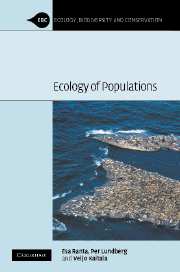Book contents
- Frontmatter
- Contents
- Preface
- 1 Introduction
- 2 Population renewal
- 3 Population dynamics in space – the first step
- 4 Synchronicity
- 5 Order–disorder in space and time
- 6 Structured populations
- 7 Biodiversity and community structure
- 8 Habitat loss
- 9 Population harvesting and management
- 10 Resource matching
- 11 Spatial games
- 12 Evolutionary population dynamics
- 13 Epilogue
- References
- Index
7 - Biodiversity and community structure
Published online by Cambridge University Press: 02 December 2009
- Frontmatter
- Contents
- Preface
- 1 Introduction
- 2 Population renewal
- 3 Population dynamics in space – the first step
- 4 Synchronicity
- 5 Order–disorder in space and time
- 6 Structured populations
- 7 Biodiversity and community structure
- 8 Habitat loss
- 9 Population harvesting and management
- 10 Resource matching
- 11 Spatial games
- 12 Evolutionary population dynamics
- 13 Epilogue
- References
- Index
Summary
This chapter is devoted to biodiversity, viz. the local and global number of coexisting species. We first show how community assembly critically depends on the interaction terms αij of the community matrix A. In an isolated community, elimination of a single species easily leads to cascading extinctions. Attempts to reintroduce the species lost may not always succeed, and may even lead to further extinctions. Extending community assembly into space enhances local and global diversity but too much dispersal among communities may considerably reduce maximum achievable species richness. We also suggest that harvesting species from a community with strong interactions may result in unexpected extinction cascades.
Community assembly
The issue of species richness ultimately translates into the concept of the ecological niche, defining the resource utilization profile of any single species either when alone or in a network of interactions with other species with closely matching profiles (e.g., Levins 1968; Emlen 1984; Lundberg et al. 2000b). The classic question now becomes how many and how similar species can (locally) coexist. This problem of local species richness crystallizes into a simple set of questions (Diamond 1975):
To what extent are the component species in a given locality or community mutually selected from a larger species pool to fit with each other?
Does the resulting constellation resist invasion?
If so, how?
To what extent is the final species composition of a community uniquely specified by the properties of the physical environment, and to what extent does it depend on chance events?
- Type
- Chapter
- Information
- Ecology of Populations , pp. 152 - 180Publisher: Cambridge University PressPrint publication year: 2005



